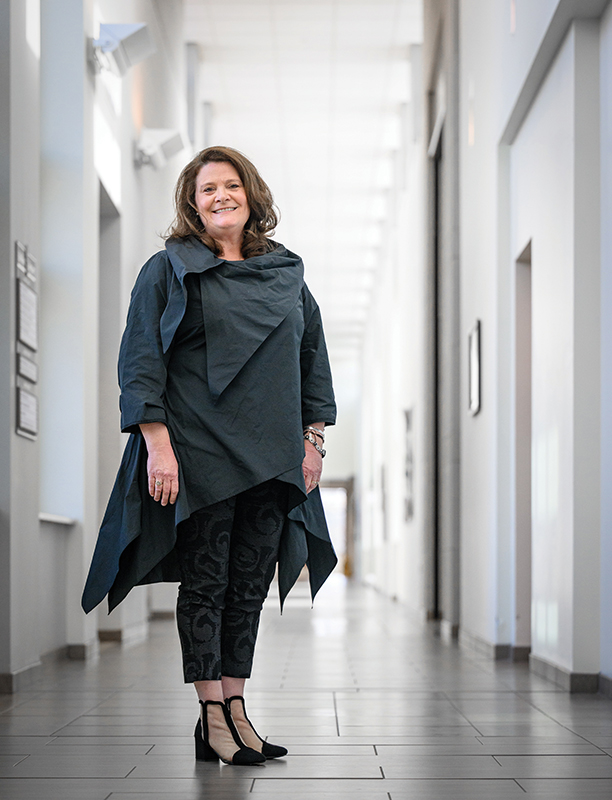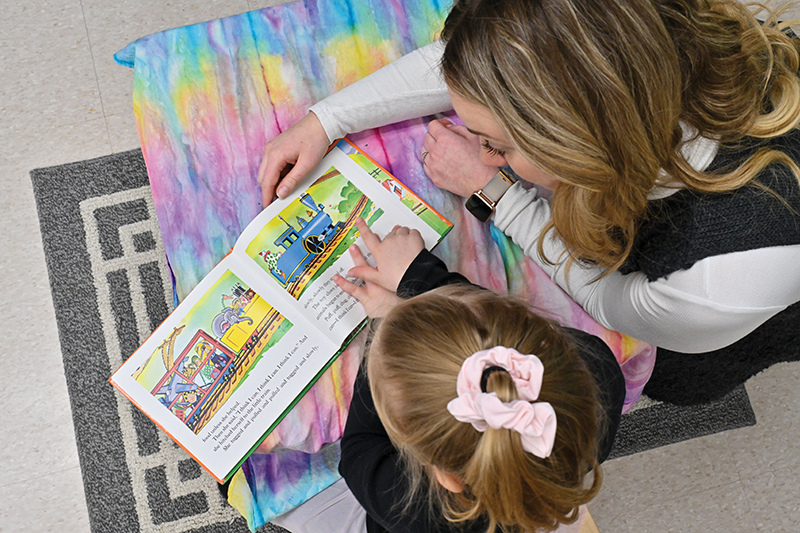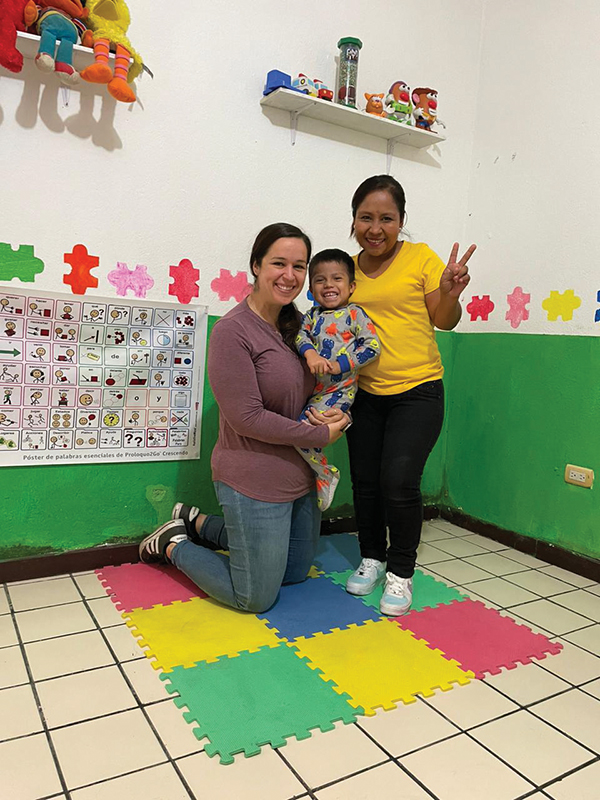Therapy Providers Ready for Today’s Field
by Lisa Knox
Living and working in Guatemala for the past 10 years, Amanda Blackwell ’09 is humbled that the nearly 1,000 speech and language therapists she has taught and trained are making an impact throughout Central and South America and Mexico. As in the rest of the world, communities in these regions are in desperate need of modern, qualified speech-language pathologists (SLPs). Blackwell has made it her life’s mission to share her techniques with as many as possible. Her approach to SLP therapy is heartfelt and intelligent, bold and relentlessly curious—qualities that keep her in demand. She’s on the road 150-plus days of the year in Spanish-speaking countries and regions, including stints in Europe and the United States—and she owes it all to Saint Mary’s.

SLP legislation and policy, has been key to the
development and growth of the speech-language
pathology program.
Speech-language pathology is a field of rehabilitation services dedicated to treating speech impairments, language and communication challenges, and swallowing problems (dysphagia). According to US estimates, one in 12 children encounters language and speech disorders. Another 9 million people suffer from dysphagia, a condition that becomes more prevalent with age. Dysphagia affects up to 1 in 5 older adults, with as many as 40 percent of that population in institutional settings such as nursing homes and assisted living facilities.
The demand for speech-language pathologists is rising. The Bureau of Labor Statistics projects job growth at 21 percent in the field through 2031 in the US alone. Making certain there are qualified therapists to meet this intensifying demand is what drives Blackwell. Meeting that need also lies at the heart of the mission of the SLP program at Saint Mary’s.
As an education major at the College, Blackwell became aware of the study of communicative disorders through a required class. Attracted by the field’s blend of science and humanity, she found herself spending more and more time with her professor, Susan Olney Latham ’91. Latham, who holds a Ph.D. in SLP and is the founding chair of the Department of Speech-Language Pathology, was developing a robust undergraduate and graduate program. Blackwell wanted to study with her.
Latham remembers Blackwell’s era on campus as revolutionary—and not just because she recognized the talent of a student who would go on to do great things in the field. The communicative disorders program at Saint Mary’s was on the cusp of becoming a leader in the industry.
Growing Students—and a Department—to Serve the Saint Mary’s Way
At the time, students could earn a minor in communicative disorders. But Latham was preparing to take the next step: launching an undergraduate major. She knew just how uniquely positioned Saint Mary’s was to train therapists who would work from their hearts, not just their minds.
“When I was starting out, I just kept thinking about how I was a different kind of speech-language pathologist,” Latham said. “As a graduate of the College, I knew it was the Holy Cross education, the liberal arts education. Everywhere I went—while earning my master’s and doctorate, while working in these clinical settings—I took a part of Saint Mary’s with me into the world. I just kept thinking Saint Mary’s had a unique opportunity to produce really awesome SLPs.”
In 2003, Latham came home to Saint Mary’s to teach and got to work building the program she envisioned. In 2009, Blackwell became the first Saint Mary’s student to earn a bachelor’s degree in communicative disorders from the College.
A master’s degree program was established five years later, and the first class graduated in 2017. Today, the program consists of a bachelor’s degree and multiple pathways to earn a master’s degree, including a 4+1 program that directly admits students as undergraduates in their first year at Saint Mary’s. Students begin graduate work in their senior year and graduate after a summer externship at the end of their fifth year. Saint Mary’s is the only college in Indiana to offer this option.
These pathways—combined with class size and the quality of degrees offered—put the Saint Mary’s College program firmly on equal footing with much larger institutions like Purdue or Indiana University, Latham says: “What makes our program stand above the others are our three on-campus service delivery models. This is an experience our students might not get otherwise until they are out working in the field.”
Three Settings Offer Students Unique Experiential Learning

Judd Leighton Speech and Language Clinic. The clinic is one of
three distinct settings on campus where students can deliver
supervised therapy for patients.
In layman’s terms, Saint Mary’s SLP students can provide supervised therapy services for individuals in three distinct settings: the Judd Leighton Speech and Language Clinic, which provides free SLP therapy for up to 60 people from the community each week; the Early Childhood Development Center, the on-campus pre-school program; and the convent, a long-term care facility for the Sisters of the Holy Cross.
“What we know from research is that SLPs should be capable of delivering therapy services in multiple ways, in order to meet the needs of the patient,” Latham explains. “We are really lucky because we take our students to ECDC to provide speech and language services, and to the convent to help the sisters with feeding services and cognitive therapy. This is in addition to the therapy we provide at the clinic. This is helping students understand in a very safe learning environment how to deliver care in a hospital-like setting.”
The clinic, open since 2014, was realized thanks to a $1 million grant from the Judd Leighton Foundation. Located in Madeleva Hall, it offers student-led, faculty-supervised speech and language services to clients from throughout St. Joseph County. Clients include individuals whose speech is affected by stroke, dementia, autism, Down syndrome, and other conditions.
The clinic, along with the rest of the Department of Speech-Language Pathology, will eventually move to its new home in the College’s Center for Integrated Healthcare Education in Regina Hall. Though no timeline has been set, the first phase of the interdisciplinary approach to healthcare education was completed in 2021, when the Department of Nursing Science relocated from Havican Hall to the Center. Speech-Language Pathology will be next, followed by the Autism Studies and Social Work programs.
Once they’re established in the new location, students can work alongside other healthcare disciplines to provide care for patients. For example, if an adult stroke patient comes to the clinic for SLP services, they will be able to work on daily living skills in the new clinic’s mock apartment. “We can make significant and meaningful progress with them, which translates to them being more independent and enjoying a higher quality of life. They might include social work and nursing students to help the family navigate other areas of healthcare.
“This interprofessional approach is critical,” Latham continued. “This is what makes our program stand out. Nobody else is providing this level of experience for their students. Providing care in this way results in the best outcomes for both students and patients.”
Teaching and Leading to Meet Community Needs
As forward-looking as the SLP program is, Saint Mary’s is located in a state ranked last in the country for caseload size per therapist. It is a devastating statistic, Latham says. To combat this, Saint Mary’s has played a major role in advocacy efforts and education over the past 20 years in Indiana. As the former president and current VP-elect of government affairs and public policy of the Indiana Speech- Language Hearing Association (ISHA), Latham spends a lot of time talking to legislators. She has been recognized for her efforts and is the recipient of Honors of the Association, the highest appreciation bestowed upon a speech-language pathologist at the state level.
She’s training her students to be advocates, as well. “Our students have been involved with the state association from day one of our program. I’m so proud that former students like Amanda, who once participated in state conventions as a student, are now presenting and leading our profession.”
In fact, Blackwell will join Latham in April to present at ISHA’s annual convention in Indianapolis. And later in the summer, Blackwell will return to campus as an adjunct professor to teach a course to SMC students. Blackwell and her colleagues also started the Association for Speech Therapists in Guatemala, Somos TLgt. After 10 years of continuous effort, she is now part of a tight-knit, professional community of more than 65 local colleagues who work to advance the standards of care in their country.
“I never went into this profession thinking that it’s purely clinical,” Blackwell says. “I always thought from the very beginning that I’m working with the whole person, connecting them with the world and its people through communication.”
A Look at the Market

Amanda Blackwell ‘09, kneeling at left, are making an impact in
Central and South America and Mexico. Because the family is
critical to a child’s success, she also spends a good deal of time
with parents and caregivers empowering them with tips and
techniques.
While recruiting students to the program is relatively easy—most graduate programs, including the one at Saint Mary’s, reach capacity at 30-35 students per cohort—expanding the range of students in the program is also important.
“I think there’s a big misconception that speech-language pathologists are restricted to being the bubbly speech teacher who comes and takes kids to speech class,” said graduate student Max Cherioli ’24. “It is so rare to find a job that totally runs the gamut of settings, populations, hours, and specialties like speech-language pathology does.” He stresses the importance of diversity in the field. “We need more queer SLPs, more male SLPs, and more SLPs of color if we really want to maximize our impact in the world.”
Latham agrees that diversity in the profession is critical, adding that women in particular need to be encouraged and supported with their education beyond the master’s, adding that while 95 percent of SLPs are women, most Ph.D.-level audiologists and speech-language pathologists are men. “We need more women pursuing their Ph.D.s to become faculty members and train the next generation of professionals. Once we have more faculty, we can expand our program and get more qualified therapists in the field,” Latham said. Blackwell is among those, having received both a doctorate of education and a doctorate of speech-language pathology.
“We are training students based on the mission of Saint Mary’s,” Latham said. “I really want our alumnae to know that if they encounter our students in their lives, they are changing the world.” When Amanda Blackwell reflects on her work in the world—becoming fluent in Spanish in order to care for her clinical patients in Central America; turning down lofty faculty positions at several US universities; holding the hand of a grateful grandmother of an autistic child in Guatemala—that is how it feels to her. She is living the mission of Saint Mary’s one family at a time.
To learn more about the Department of Speech-Language Pathology, visit saintmarys.edu/academics/departments/speech-language-pathology
